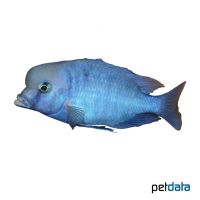Malawi Blue Dolphin (Cyrtocara moorii)
| Malawi Blue Dolphin Cyrtocara moorii | |
|---|---|
| Name | Malawi Blue Dolphin |
| Name Lat. | Cyrtocara moorii |
| Family | Cichlids |
| Family lat. | Cichlidae |
| Order | Cichlids |
| Order lat. | Cichliformes |
| Origin | Lake Malawi |
| Habitat | Sandy zone |
| Diet | Carnivore |
| pH | 7.5-8.8 |
| Behavior | Semi-aggressive |
| Keeping | Harem |
| Care Level | Difficult |
| Reproduction | Oviparous |
| Breeding | Moderately difficult |
| Life Span | 8-10 years |
| Protection | No |
| Metric Units | |
| Size | 18-20 cm |
| Temperature | 24-28 °C |
| Hardness | 10-25 °dH |
| Aquarium | ~ 500 l |
| US Units | |
| Size | 7"-8" |
| Temperature | 75-82 °F |
| Hardness | 178-445 ppm |
| Aquarium | ~ 130 gal |
Distribution and habitat
The bulge-headed mouthbrooders occur exclusively (endemically) in Lake Malawi and are widespread throughout the lake. They prefer to live in calm bays with sandy bottoms, where they usually stay near the shore in 3-15 m water depth.
Maintenance
The aquarium should have large, open sandy areas and only be structured with isolated boulders and offer a lot of free swimming space. A loose background and edge planting of vallisneria and a light-colored substrate of sand or fine gravel is ideal.
No ammonia, ammonium and nitrite should be detectable, the nitrate value should not exceed 100 mg/l. To ensure the water quality and oxygen content, a filter and heater adapted to the aquarium size is required, as well as lighting for the species-appropriate day-night rhythm of the animals.
Diet
The food supply consists of live, frozen and dry food. For a balanced diet, feed once a day with a high-quality, protein-rich dry food for cichlids (flakes, granules, pellets) as well as daphnia, Artemia mysis, mosquito larvae, etc. (live or frozen).
It is recommended to feed small portions several times a day. Only feed as much as will be eaten within a few minutes. A regular and varied diet promotes health and increases resistance.
Behaviour and compatibility
With their calm temperament, they are one of the more peaceful Malawi cichlids. They should be kept in a harem, one male with 3-5 females. During the spawning season males defend their territory vehemently within the species. Keeping several harems is only recommended in a much larger and richly structured tank. A socialization with other peaceful cichlids (non-Mbunas), like Fossochromis rostratus and featherbeard catfishes is well possible. Fish that are too small are considered prey.
Basically, only compatible fish species with similar demands on water condition and water temperature may be socialized.
Sex dimorphism
The sexes are difficult to distinguish. The male is slightly more solid blue in color and larger than the female. Adults of both sexes get an impressive forehead hump.
Reproduction and breeding
They are maternal mouth brooders. The female spawns 20-90 eggs on sand or a flat rock. After fertilization by the male, the female immediately takes them into her throat pouch for mouth brood care and keeps the fry in her throat pouch even after hatching. After about 3 weeks, the fry are released and brood care ends. Throughout brood care, the female does not consume food. The fry grow very slowly.
Fry must be fed several times a day with special rearing food (Artemia nauplii). In a community tank breeding is hardly possible, because the fry are easy prey.
Important
In their natural environment, they accompany sand boars, such as Lethrinops or Fossochromis, as they scour the soil for food, feeding on the microbes that are stirred up.
The well-being of the fish should be checked regularly. Temperature should be checked daily, pH, hardness and nitrate levels at least every 14 days. A regular partial water change is recommended, even if the pollutant load has not yet reached the upper limit. Sudden changes in water quality should be avoided. Newly introduced fish must be accustomed slowly to the water in the aquarium.
Further literature can be found in your pet store.
References
Text: Werner Winter; Image: petdata
Source: BMELV (1998): Tierschutzgutachten - Haltung von Zierfischen (Süßwasser); RIEHL & BAENSCH (2006): Aquarien Atlas Bd. 1, Mergus Verlag; ENGELMANN (2005): Zootierhaltung - Tiere in menschlicher Obhut: Fische, Verlag Harri Deutsch
- Gemäß § 21 Abs. 5 Tierschutzgesetz idgF
